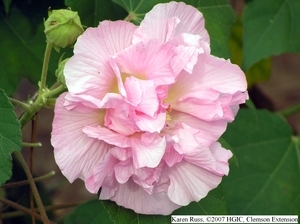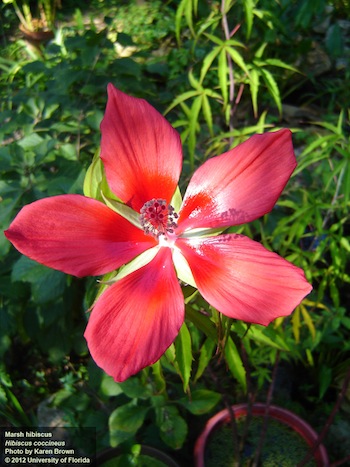Hibiscus: An Easy Plant For a Flash of Color
Plants we love
 By Marsha Goldberg, Fairfax Master Gardener
By Marsha Goldberg, Fairfax Master Gardener
If you love a garden that is not shy about showing off its colors, hibiscus may be the perfect plant for you. Often known as rose mallow (although that is just one cultivar), hibiscus is related to and often confused with hollyhock and rose-of-Sharon. All are members of the mallow family, which includes more than 250 species.
Because there are so many hibiscus cultivars that look and perform differently, it is helpful to familiarize yourself with them before buying one so you can be sure that your choice meets the needs of your garden.
 There are both annual and perennial cultivars of hibiscus. The perennial versions are generally cold hardy in our area, although they may not tolerate extremely low temperatures. Many people grow both annual and perennial hibiscus in containers and bring them inside in the winter, where they treat them like houseplants. The plants come in a wide range of colors, including white, pink, purple, red and yellow. Flower size can vary as well, from just a few inches across to as much as 8 inches. Each flower may last only a day, but the shrub blooms continuously from late summer through fall. Large-flowering types — such as Lord Baltimore and Cinnamon Grappa — feature huge blooms on bushes that typically reach 5 to 6 feet tall but can grow as high as 15 feet. They create a long-lasting riot of rich color that will stand out in your yard, while bushes with smaller flowers, such as the soft pinks of Confederate Rose, are more subdued. Dwarf varieties such as Hibiscus hirtus and Hibiscus luna can produce similarly large blooms, although the shrub may grow to only three feet.
There are both annual and perennial cultivars of hibiscus. The perennial versions are generally cold hardy in our area, although they may not tolerate extremely low temperatures. Many people grow both annual and perennial hibiscus in containers and bring them inside in the winter, where they treat them like houseplants. The plants come in a wide range of colors, including white, pink, purple, red and yellow. Flower size can vary as well, from just a few inches across to as much as 8 inches. Each flower may last only a day, but the shrub blooms continuously from late summer through fall. Large-flowering types — such as Lord Baltimore and Cinnamon Grappa — feature huge blooms on bushes that typically reach 5 to 6 feet tall but can grow as high as 15 feet. They create a long-lasting riot of rich color that will stand out in your yard, while bushes with smaller flowers, such as the soft pinks of Confederate Rose, are more subdued. Dwarf varieties such as Hibiscus hirtus and Hibiscus luna can produce similarly large blooms, although the shrub may grow to only three feet.
 Hibiscus can make a striking display when planted at the back of a flowerbed, especially when paired with plants that bloom and finish early, such as peonies or irises. They also provide an excellent accent along the foundation of a house, which works well because the shelter of a wall can prevent strong winds from snapping their tall stems. Hibiscus needs to be planted in full or part sun; too little light and they will grow tall and leggy and not flower as much as plants getting more light. They do best in evenly moist, slightly acidic, organically rich soil and can tolerate wet soil. However, easy-going hibiscus can survive occasional dry periods. Planted in the right soil, they do not need fertilizer but will benefit from a light application of nitrogen. They do well with an annual application of compost and, for first-year plants or in very cold regions, a layer of straw or bark mulch is helpful.
Hibiscus can make a striking display when planted at the back of a flowerbed, especially when paired with plants that bloom and finish early, such as peonies or irises. They also provide an excellent accent along the foundation of a house, which works well because the shelter of a wall can prevent strong winds from snapping their tall stems. Hibiscus needs to be planted in full or part sun; too little light and they will grow tall and leggy and not flower as much as plants getting more light. They do best in evenly moist, slightly acidic, organically rich soil and can tolerate wet soil. However, easy-going hibiscus can survive occasional dry periods. Planted in the right soil, they do not need fertilizer but will benefit from a light application of nitrogen. They do well with an annual application of compost and, for first-year plants or in very cold regions, a layer of straw or bark mulch is helpful.

Marsh Hibiscus
Members of the mallow family are occasionally damaged by deer, according to Rutgers New Jersey Agricultural Experiment Station, Landscape Plants Rated by Deer Resistance, which rates plants for deer resistance. In addition, Japanese beetles, whiteflies, aphids, scale, thrips and mites may bother hibiscus, but they can usually tolerate these infestations. They are susceptible to foliar diseases such as powdery mildew, downy mildew and botrytis, but these are usually easy to control.
Resources
American Hibiscus Society, as an excellent web site with good information
Hibiscus Provides a Touch of Tropics, Diane Betts, Colorado State University Extension
Hibiscus, Karen Russ, Clemson Clemson Cooperative Extension
Tropical Hibiscus, Texas AgriLife Extension Service/Galveston County Master Gardeners
Hibiscus: A Plant That Blooms All Year, Dr. Dave Williams, Alabama Cooperative Extension System